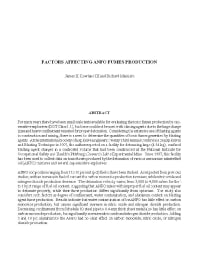Mining Publication: Factors Affecting ANFO Fumes Production
Original creation date: February 2000
Authors: JH Rowland, RJ Mainiero
NIOSHTIC2 Number: 20021058
Proceedings of the 26th Annual Conference on Explosives and Blasting Technique (Anaheim, CA, Feb. 13-16, 2000). Vol. 1. Cleveland, OH: International Society of Explosives Engineers, 2000 Feb; :163-174
For many years there have been small scale tests available for evaluating the toxic fumes production by cap-sensitive explosives (DOT Class 1. l), but these could not be used with blasting agents due to the large charge sizes and heavy confinement required for proper detonation. Considering the extensive use of blasting agents in construction and mining, there is a need to determine the quantities of toxic fumes generated by blasting agents. At the International Society of Explosive Engineers Twenty Third Annual Conference on Explosives and Blasting Technique in 1997, the authors reported on a facility for detonating large (4.54 kg), confined blasting agent charges in a controlled volume that had been constructed at the National Institute for Occupational Safety and Health's Pittsburgh Research Lab's Experimental Mine. Since 1997, this facility has been used to collect data on toxic fumes produced by the detonation of various ammonium nitrate/fuel oil (ANFO) mixtures and several cap-sensitive explosives. ANFO composition ranging from 1 to 10 percent (pct) fuel oil have been studied. As expected from previous studies, with an increase in fuel oil content the carbon monoxide production increases, while nitric oxide and nitrogen dioxide production decrease. The detonation velocity varies from 3,000 to 4,000 m/set for the 1 to 10 pet range of fuel oil content, suggesting that ANFO mixes with improper fuel oil content may appear to detonate properly, while their fume production differs significantly from optimum. The study also considers such factors as degree of confinement, water contamination, and aluminum content on blasting agent fume production. Results indicate that water contamination of the ANFO has little effect on carbon monoxide production, but causes significant increase in nitric oxide and nitrogen dioxide production. Decreasing confinement from Schedule 80 steel pipe to 0.4-mm thick sheet metal also has little effect on carbon monoxide production, but significantly increases nitric oxide and nitrogen dioxide production. Adding 5 and 10 percent aluminum to the ANFO had no clear effect on carbon monoxide, nitric oxide, or nitrogen dioxide production.

NIOSHTIC2 Number: 20021058
Proceedings of the 26th Annual Conference on Explosives and Blasting Technique (Anaheim, CA, Feb. 13-16, 2000). Vol. 1. Cleveland, OH: International Society of Explosives Engineers, 2000 Feb; :163-174
- A 20-Liter Furnace Test Method to Determine the Combustion Gas Toxicity of Conveyor Belts
- Behavior of Nitrogen Oxides in the Product Gases from Explosive Detonations
- Chemical and Physical Factors that Influence N0x Production During Blasting: Exploratory Study
- Dangers of Toxic Fumes from Blasting
- Factors Affecting Fumes Production of an Emulsion and ANFO/Emulsion Blends
- Field Studies of CO Migration from Blasting
- Monitoring and Removal of CO in Blasting Operations
- Personal Air Safety System (PASS)
- Technology News 488 - Migration of Blasting Fumes into a Western Pennsylvania Home
- Toxic Fume Comparison of a Few Explosives Used in Trench Blasting